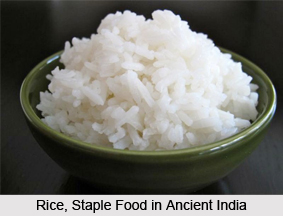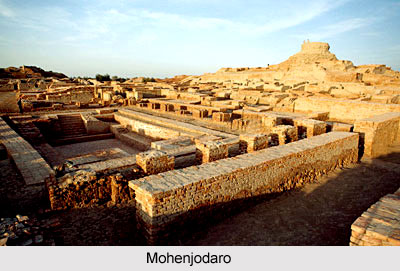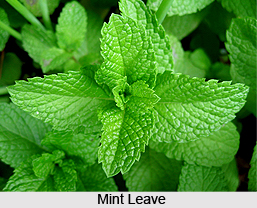 Botanical name:Mentha arvensis Linn.
Botanical name:Mentha arvensis Linn.
Family name:Labiatae.
Indian names are as follows:
Hindi, Bengali, Gujarati, Marathi, Punjabi, and Urdu:Pudina
Kashmiri:Pudyanu
Malayalam:Muthina
Tamil, Telugu:Pudina.
Pudina is known to almost all the Indians, as used in `chutney` and as an old popular remedy for relieving stomach complaints and cough and cold. In fact many branded medicines are now being prepared using Pudina as principal raw material.
However, the world demand for peppermint oil and menthol is met from the following three species, which have also been approved/recognized, by the ISO (International Organization for Standardization) for the purpose of quality standard and international marketing:
Mentha arvensis Linn. Var. Piperascens malinvaud, Mentha piperita Linn. Var piperita, Mentha spicata Linn. Syn: Mentha virides Linn.
Here the discussion is limited to `arvensis` species. This species was introduced in India almost recently. In 1952 A.D, rooted suckers of Japanese mint (Mentha arvensis Linn var piperascens) obtained from Japan and planted in Jammu and Kashmir, gave promising results with regard to their growth and yield of oil. There after it started spreading in other states with identical agro-climatic condition.
Japanese mint is a downy perennial herb with running rootstocks and rigid branching stem, 60 to 90 cm high, cultivated at an altitude of 270 to 1500 meters. This species is more robust than Mentha arvensis. It does not breed true from seed. Due to its wide adaptability, it can be cultivated all over India. Temperate to tropical climates suit it well. Sunny weather with moderate rainfall is conducive to its luxuriant growth and high menthol content.
In arvensis, the introduced strain Japanese mint is now well adapted under different agro-climatic conditions of the country. Jammu mint, which is a tetraploid of Japanese mint, gives as high as 5% oil (dry weight) as compared to an average of 2.5 to 3% in the normal diploid. The world`s demand for Japanese mint oil or Japanese peppermint oil, as commonly known, and natural menthol is met mainly from Japan and to a lesser extent from China and Brazil. Considering quality of plant as well as the oil extracted in our country, India stands a good chance to share major share of this trade.
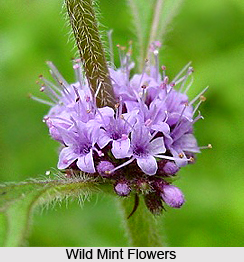 The mint crop gives maximum oil content when it has just reached the flowering stage, after which the oil content begins to decline, but in cases where there is delayed flowering, as at Delhi, yellowing of the lower leaves is an indication for cutting in time. About 2 to 3 cuttings are done during the season. Freshly cut herb is left in the field for 2 to 4 hours during the sunny weather. This partially dried herb is further dried in small bundles by hanging over wires in shades till it is reduced to 1/3rd or 1/4th of its original weight, taking care that the leaves do not get crisp. The crop should not be heaped for drying in the sun as it is reported to result in reduction of oil by about 20 to 25%.
The mint crop gives maximum oil content when it has just reached the flowering stage, after which the oil content begins to decline, but in cases where there is delayed flowering, as at Delhi, yellowing of the lower leaves is an indication for cutting in time. About 2 to 3 cuttings are done during the season. Freshly cut herb is left in the field for 2 to 4 hours during the sunny weather. This partially dried herb is further dried in small bundles by hanging over wires in shades till it is reduced to 1/3rd or 1/4th of its original weight, taking care that the leaves do not get crisp. The crop should not be heaped for drying in the sun as it is reported to result in reduction of oil by about 20 to 25%.
Distillation of dried leaves is cheaper than that of fresh leaves. By steam distillation and filtration, a golden yellow volatile oil is obtained. Leaves and flowering tops gives the highest yield. About 50% of menthol can be separated out in crystalline form on cooling the oil. The remaining (dementholised) oil is used as peppermint oil. Manufacture of menthol from dementholised oil has been taken up on commercial scale by three or four firms in Maharashtra, West Bengal and Gujarat.
The peppermint oil is stored in colored bottles, airtight aluminium or galvanized containers in cool dry place. Presence of moisture in oil may rancidify the oil. Since it is acidic in nature, it should not be stored in tin containers.
The natural oil yields on an average 40 to 50% menthol and 50 to 60% dementholised oil, which can be used both in confectionery and medicine in place of imported peppermint oil. Japanese mint oil is not distinguished from the peppermint oil in Indian trade. The dementholised oil has been found to contain menthyl acetate (24.4%), free menthol (44.8%), menthone (24.6%) and hydrocarbons (6.2%). Among the hydrocarbons, alpha-pinene, alpha-l-limonene, caryophyllene and cademene are present.
The oil and the dried plant are antiseptic, carminative, refrigerant, stimulant and diuretic. The dried plants does not have a good taste as it is, but it is expectorant, emmenagogue, tonic to kidney, useful in diseases of the liver and spleen, asthma etc. It also possesses anti-spasmodic properties, is used in jaundice, and frequently given to stop vomiting.
In China, the leaves and stems are made into an infusion and used As carminative, sudorific and anti-spasmodic.
Pudina or Mint is very popular for use in the common `Pudina/Dhania` chutney. This chutney with various combinations can be packed with preservatives and be sold as ready to use chutney. Mint is also used for flavoring meat, fish, sauces, soups, stews, vinegar, teas, tobacco and cordials. The fresh leaf tops of all the mints are used in beverages, fruit cups, applesauces, ice cream, jellies, salads and sauces for fish and meat. Roast lamb and mint jelly have become inseparable companions.
Japanese mint oil finds uses similar to that of peppermint oil. However, the latter is preferred for flavoring purposes. It is used for the production of natural menthol. Dementholised oil is employed flavoring in mouthwashes, toothpastes and pharmaceutical preparations. The main use of mint is the extraction of volatile oil which contains menthol and is used in medicines for stomach disorders, in ointment or balm for headaches, rheumatism and other pains, in cough drops, inhalation etc.
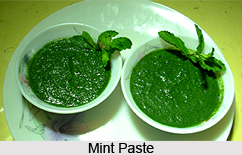
This plant therefore is a wonderful plant that can give us a number of useful products. It shall give use much valued volatile oil, a number of food products having popularity, and various types of medicines. Just by growing it at backyard, it may be handy for home remedy and of course to make chutney.
Under above circumstances, this resource can be considered as a valuable resource to plan rural industrialization programme. The units can be of different range, depending on end products and level of entrepreneurs may be of different level depending on background of the project. What is important being, all these products have demand both in domestic and international market, hence cash flow is always ensured.

